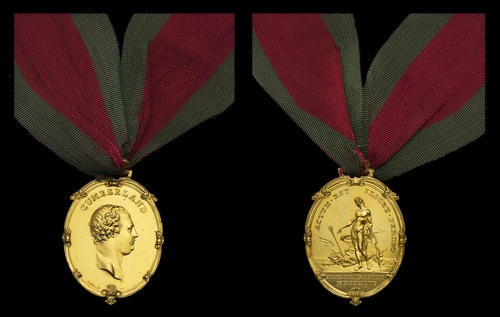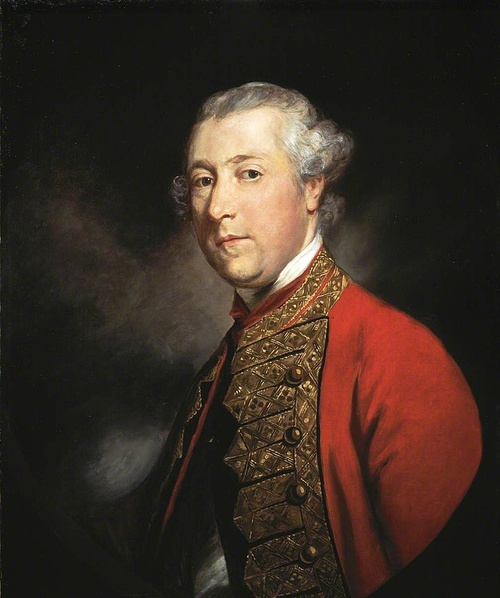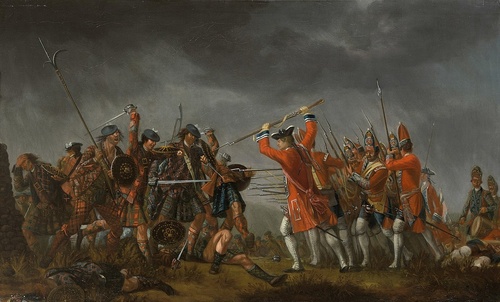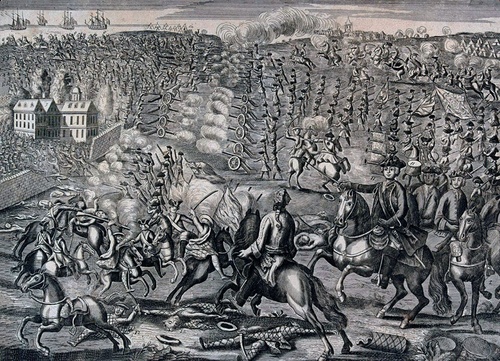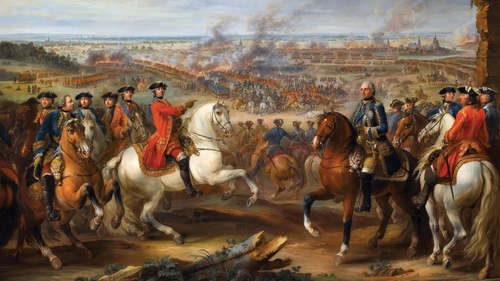Auction: 24003 - Orders, Decorations and Medals
Lot: 161
The important and unique Cumberland Society Gold Medal awarded to Field Marshal Sir G. Howard, 3rd Regiment of Foot (The Buffs), who commanded that famed unit at the Battles of Fontenoy, Culloden, Lauffield and Warburg
He went on to serve as Governor of Minorca and Jersey and thence became Governor of the Royal Hospital Chelsea, the fifth man to take on the position, one which he held for nearly three decades
Cumberland Society Gold Medal, by Richard Yeo, scrolled border, the obverse with the head of the Duke with the name 'CUMBERLAND' above, the reverse with the standing figure of Apollo leaning on his bow pointing to a wounded dragon with the legend 'ACTU, EST ILLICET PERIIT' above and 'PROEL. COLOD. AP. XVI MDCCXLVI' below, with integral scrolled suspension loop and retaining its original crimson riband with green edges, 51mm x 38mm oval, minor contact marks, very fine
Spink XRF test confirms 97.5% gold purity, weight 42g.
Provenance:
Field Marshal Sir George Howard K.B.
Captain John Hamilton.
Returned to the family in the late 19th century and by descent to the late Richard Howard-Vyse.
Christie's. November 2011, The Property of the Late Richard Howard-Vyse.
Believed to be the only attributed example available and the only surviving upon its original riband.
K.B. bestowed 1763.
George Howard was born at Eastwick House, Great Bookham, Surrey on 17 June 1718, the son of Mary and Lieutenant-General Thomas Howard. He attended Westminster School and went up to Christ Church College, Oxford and gained a commission in the 24th Regiment of Foot, at that stage commanded by his father, in Ireland on 20 February 1925.
His father was transferred to the Colonelcy of the 3rd Regiment of Foot (The Buffs) in 1737 and the younger Howard joined him with the rank of Captain. They entered the War of Austrian Succession in Flanders in 1742, at the time most Regiments were known by the name of their commanders however two Regiments were commanded by Howards. As such the 3rd were known as the 'Buff Howards' after their coat facings, while what became the 19th (Yorkshire) Regiment were the 'Green Howards'.
First Taste of Powder
Howard was advanced to the rank of Lieutenant-Colonel on 2 April 1744 and took command of the Regiment from his father. The next year they were to take part in the extremely bloody Battle of Fontenoy, earning a reputation for stubbornly advancing despite the odds. They attacked between the villages of Fontenoy and the Redoute D'Eu, an early attempt to take this latter feature failed and a general attack was begun with the redoubt still in French hands on the British flank.
Advancing under the slope before the French army under a crossfire from the French held positions the British infantry under Sir John Ligonier found themselves at the centre of a storm of fire which held them fast. They continued to push hard against the French lines but proved unable to penetrate them, eventually Ligonier was forced to come forward and call the Buffs back in person. Finally consenting to withdraw the Battalion aided the rearguard of the Allied army, holding Vizen churchyard against the advancing French.
This same victory encouraged the French to provide the Young Pretender, Charles Stuart with two warships to transport the Jacobites of the French court to Scotland. The 1745 Rising began on 19 August when Charles raised his standard at Glenfinnan, defeating a Royal army at Prestonpans on 21 September. The result of this was the recall of the Duke of Cumberland with 12,000 men from Flanders to end the revolt.
The Battles of Falkirk and Culloden
The Regiment was present for the Battle of Falkirk Muir in January 1746 where they formed the third rank of the Royal line. The highlander charge sent the Royal troops fleeing for their camp and it was only the steady withdrawal of several regular units which saved the army from being seriously mauled. However, while the Battle ended in a Jacobite victory, it was not a decisive one and Howard's Buffs were still intact enough to take part in the climactic Battle of Culloden.
Charles initially decided to fight that battle defensively on the boggy Drummossie Moor, against the advice of his commanders, thus exposing himself to the fire of the Government artillery. They stood for an hour under a storm of roundshot and grapeshot and eventually it was clear that he had no option but to attack.
The famous Highland charge was hampered by the boggy ground and, thus slowed, found themselves exposed to a heightened storm of fire from the British Infantry. These troops had seen heavy fighting on the continent and stood firm in the face of their attackers, loading and firing admirably. The Jacobite left, somewhat sheltered by the folds in the rough terrain were able to connect with the British line, where they were confronted by the new bayonet drill instituted by Cumberland.
Howard's 'Old Buffs' were stationed in the second line and suffered comparatively light losses in the fighting, although that was true of all the Royal Army expect for the 4th and 37th Regiments. Unlike previous battles the Government Army did not break upon entering hand-to-hand combat and instead it was the highlanders who Cumberland ordered up troops from the second line to support the first.
The survivors fled, coming under a heavy fire as they withdrew only to find cavalry on their flanks who drove them from the field, turning a retreat into a headlong flight. The Irish Picquets covered the withdrawal of the army however the damage had been done and the battle effectively marked the end of the rising and indeed the Jacobite cause.
Cumberland's Army advanced into Scotland, re-garrisoning the forts that had been taken and launching punitive expeditions against those clans which had supported the Jacobites. Howard was certainly with them and doubtless participated in the bloody repercussions that followed.
The Cumberland Society
The society was founded as a drinking club on the day after the Battle by the 27 senior offices in the army, 27 being the age of the Duke of Cumberland when Culloden took place. It was decided that one more officer being added every year on the Duke's birthday, meeting on that same day 15 April which was also the anniversary of the eve of the Battle. They met ever year until 1776, the year after his death.
All of these senior officers received a large Gold Medal which was to be worn upon a green edged crimson ribbon, the first time a medal was worn upon a specific ribbon. It is known that the medal was to be worn in battle by its members and- should an example be lost under fire- would be replaced by the society, this was known to have happened at Braddock's Defeat in 1758 when Major William Sparkes lost his medal. The exact number of strikings is unknown however it is safe to assume that with only 54 members of the society less than 60 were struck, of which very few have survived.
Return to the Continent
The end of the Rising did not see the end of war with France and Cumberland returned to the continent, taking with him his comrades from Culloden. They faced the French again under Maurice de Saxe- the Victor of Fontenoy- on 2 July 1747 at Lauffeld. This was to prove another disaster; Cumberland ordered the Allied troops to leave the village of Lauffeld only to order them to re-occupy the position almost at once.
This caused great confusion and as the Allied troops hesitated the French attacked, the village changed hands several times with the infantry seeing the bulk of the action. As the British prepared for another assault the Dutch cavalry in the centre of the Allied lines broke, forcing the rest of the army to retreat as well. Only the reckless bravery of Earl Ligonier commanding the cavalry saved the Allied army, though he was made a prisoner as a result. While the battle ended in a defeat for the Allied army the French had failed to destroy their army in the field, slowing their advance.
The war ended the next year in 1748, although it was not to be the last time Howard fought the French. In the meantime while he had been commanding the Regiment in the field he was not its Colonel, still his father by now 64, however in 1749 he succeeded to the role.
The outbreak of the Seven Years War in 1756 saw the British desperate to make use of their powerful navy to counter the strength of their French and Spanish opponents on land. This led to the Descent of Rochefort in September 1757 led by Sir John Mordaunt- a senior officer who had served at Culloden and been presented with Prince Charles' coach after the battle as a reward for his service.
The raid proved a disaster, after several delays they reached Ile-d'Aix and taking the French their totally by surprise, however Mordaunt refused to attack. After much indecision the British withdrew having achieved little, this did however free up Howard for service in France.
High Command
Promoted Major-General on 24 January 1758 he was given command of a Brigade and served under another Culloden veteran, John Manners, Marquess of Granby. Granby commanded the British troops serving under the Duke of Brunswick on the continent, defending the Prussian flank while Frederick was locked in conflict with the Russian and Austrian armies. Howard commanded his Brigade during the Battle of Warburg on 31 July 1760, successfully preventing the French from crossing the Diemel River in Westphalia.
The battle was a success for the Allied army, it is not clear where Howard commanded however Granby was in command of the British Cavalry during the action. They performed superbly, forced marching to reach the battlefield in time and launching an immediate charge against the French horse, sending them tumbling into a retreat over the river. Granby kept up the pursuit as far as he could before French reinforcements forced him to return to the Allied lines.
Howard was advanced Lieutenant-General on 14 March 1761 and the same year became MP for the rotten borough of Lostwithiel in Cornwall. Appointed Colonel of The Queen's Own Royal Regiment of Dragoons on 18 August 1763, the same year he was appointed a Knight of the Order of the Bath. Leaving his Parliamentary post in 1766 Howard was given the role of Governor of Minorca which he held for two years before going on to become Governor of the Royal Military Hospital, Chelsea.
Elected as the Second Member of Parliament of Stamford the same year Howard remained in that role for some years. Being advanced General on 6 September 1777 he was appointed Colonel of the 1st (The King's) Dragoon Guards in in April 1779. Leaving Parliament for the second time at some stage in the early 1790s Howard was the third most senior officer in the British Army when the rank of Field Marshall was reinstated and was promoted to the rank on 18 October 1793.
Appointed Honorary Governor of Jersey in July 1795 he died the next year on 16 July 1796 at his home in Grosvenor Square, being buried at Great Bookham, Surrey; sold together with copied research and former auction listings.
Subject to 20% VAT on Buyer’s Premium. For more information please view Terms and Conditions for Buyers.
Sold for
£45,000
Starting price
£30000

